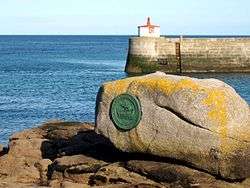Mora (ship)
Mora was the name of William the Conqueror's flagship, the largest and fastest ship in his invasion fleet of 700 or more ships[lower-alpha 1] used during the Norman conquest of England in 1066.

The ship
Mora was a ship of Drakkar design and clinker construction built at Barfleur in Normandy,[1] a gift of Matilda of Flanders to her husband William the Conqueror in the summer of 1066.[2] She was a larger ship and carried ten knights with their entourages and equipment.[lower-alpha 2] The ship was captained by Airard Fitz Stephen, meaning the son of Stephen,[lower-alpha 3] who remained her captain until William's death in 1087.[3] Stephen received lands in Hampshire, Berkshire, and Warwickshire as reward for his services in the English campaign of 1066.[4] Orderic describes the ship: "it had for its figurehead the image of a child, gilt, pointing with its right hand towards England, and having in its mouth a trumpet of ivory.[5] Mora carried multicoloured sails and at the top of the mainmast was the papal banner, consecrated and sent to William from Rome.[6] The banner was described as "a square white banner charged with a gold cross within a blue border."

Voyage to Pevensey
On the evening of 27 September 1066, before sunset according to William of Poitiers, Duke William's invasion fleet embarked for England with the Mora in the lead.[7] She carried a lantern on her mast so she could be seen and a horn was blasted as a signal to the other ships following.[7] Mora, larger than the other ships, was also much faster. William found himself in mid-channel, alone, with no other ships in sight at daybreak. Waiting on the others to catch up, he had breakfast with wine. Once the others were in sight the fleet proceeded to Pevensey in Sussex.[7]
Her name
According to Elisabeth van Houts, the meaning of the name isn't known although there have been several suggestions.[8] She might have been named for the Morini, ancient inhabitants of Flanders, as a reference to Matilda's Flemish origins.[8] The Latin word mora has several meanings, none of which seem likely. These range from 'delay' or 'pause' to 'foolish' or 'foolish woman'. Also is the possibility that Mora was an anagram of Amor.[8]
There is a more detailed analysis of the multiple meanings and possible origins of the name in the academic paper "The multiple meanings of Mora, the flagship of William the Conqueror" by Elisabeth Waugaman.[9]
Notes
- The size of the fleet has been estimated of something between 696 and 3,000 ships of all sizes which transported an estimated 10,000 men, 2,000 to 3,000 horses, and all supplies sufficient to support the invasion forces. At the time of the Norman invasion of England, it was considered the largest amphibious operation since the early days of the Roman Empire. See: Bernard S. Bachrach, 'On the Origins of William the Conqueror's Horse Transports', Technology and Culture, Vol. 26, No. 3 (Jul., 1985), p. 505-531. Also see: Edd Wheeler, 'The Battle of Hastings: Math, Myth and Melee', Military Affairs, Vol. 52, No. 3 (Jul., 1988), p. 128-134.
- A large ship could carry 40 to 45 armed men (not counting the ship's crew) or ten to twelve knights, whose entourage and equipment required more ship space. Edd Wheeler, 'The Battle of Hastings: Math, Myth and Melee', Military Affairs, Vol. 52, No. 3 (Jul., 1988), p. 128-134.
- His son was Thomas FitzStephen, the captain of the famous White Ship, which sank in the English Channel off the Normandy coast in 1120. See: Elisabeth M.C, van Houts, 'The Ship List of William the Conqueror', Anglo-Norman Studies X: Proceedings of the Battle Conference 1987, Ed. R. Allen Brown (Woodbridge: The Boydell Press, 1988), p. 173.
References
- Paul Hilliam, William the Conqueror: First Norman King of England (New York: Rosen Publishing Group, 2005), p. 39
- David C. Douglas, William the Conqueror (Berkeley & Los Angeles: The University of California Press, 1964), p. 190
- Elisabeth M.C, van Houts, 'The Ship List of William the Conqueror', Anglo-Norman Studies X: Proceedings of the Battle Conference 1987, Ed. R. Allen Brown (Woodbridge: The Boydell Press, 1988), pp. 172-73
- Elisabeth M.C, van Houts, 'The Ship List of William the Conqueror', Anglo-Norman Studies X: Proceedings of the Battle Conference 1987, Ed. R. Allen Brown (Woodbridge: The Boydell Press, 1988), p. 173
- Ordericus Vitalis, The Ecclesiastical History of England and Normandy, Trans. Thomas Forester, Vol. I (London: Henry G. Bohn, 1853), p. 465 n. 1
- G.H. Preble, 'The "Mora", A.D. 1066', The New York Times, June 3, 1883
- Christopher Gravett, Hastings 1066 (Revised Edition): The Fall of Saxon England (Osprey Publishing, Ltd., 1992), p. 47
- Elisabeth M.C, van Houts, 'The Ship List of William the Conqueror', Anglo-Norman Studies X: Proceedings of the Battle Conference 1987, Ed. R. Allen Brown (Woodbridge: The Boydell Press, 1988), p. 172
- Presented at the 34th Annual Medieval and Renaissance Forum at Plymouth State University (April 19-29, 2013), copyright 2014, The Public Heritage Institute at Regis College.